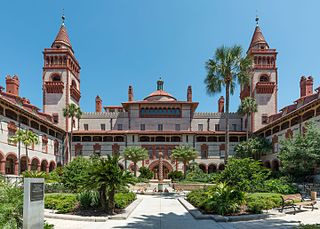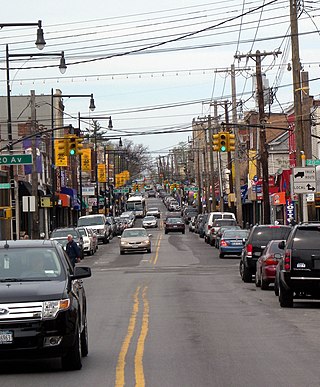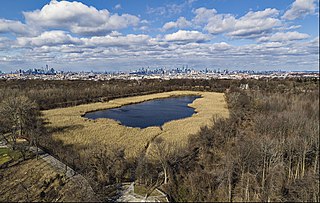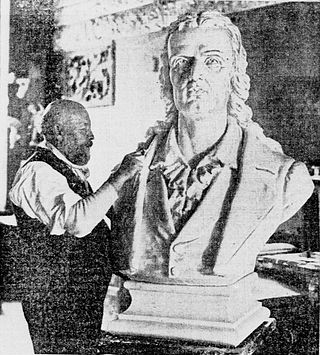
Tougaloo College is a private historically black college in the Tougaloo area of Jackson, Mississippi. It is affiliated with the United Church of Christ and Christian Church. It was originally established in 1869 by New York–based Christian missionaries for the education of freed slaves and their offspring. From 1871 until 1892 the college served as a teachers' training school funded by the state of Mississippi. In 1998, the buildings of the old campus were added to the National Register of Historic Places.

The Ponce de Leon Hotel, also known as The Ponce, was an exclusive luxury hotel in St. Augustine, Florida, built by millionaire developer and Standard Oil co-founder Henry M. Flagler and completed in 1888. The hotel was designed in the Spanish Renaissance style as the first major project of the New York architecture firm Carrère & Hastings, which would go on to gain world renown.

College Point is a working-middle-class neighborhood in the New York City borough of Queens. It is bounded to the south by Whitestone Expressway and Flushing; to the east by 138th Street and Malba/Whitestone; to the north by the East River; and to the west by Flushing Bay. College Point is a mostly residential ethnically diverse community with some industrial areas. The neighborhood is served by several parks and contains two yacht clubs.

Old Queens is the oldest extant building at Rutgers University and is the symbolic heart of the university's campus in New Brunswick in Middlesex County, New Jersey in the United States. Rutgers, the eighth-oldest college in the United States, was founded in 1766 during the American colonial period as Queen's College. Queen's College was named for Charlotte of Mecklenburg-Strelitz, the daughter of a German duke who became the queen consort of British king George III. Old Queens is located on a six-acre hilltop city block bounded by Somerset Street, Hamilton Street, College Avenue and George Street that was previously an apple orchard. Donated to the college in 1807 by James Parker, Jr., this city block become known the Queen's Campus and is the historic core of the university. Because of this, by metonymy, the name "Old Queens" came to be used as a reference to Rutgers College and is often invoked as an allusive reference to the university or to its administration.

Ridgewood Reservoir is a decommissioned 19th century reservoir and freshwater wetland that sits on the Brooklyn–Queens border in New York City, within what is now Highland Park. Although the reservoir was originally built to secure a reliable water supply for the City of Brooklyn, it is positioned on the Queens side of the border in the neighborhood of Glendale. The reservoir and park are bounded on the north by the Jackie Robinson Parkway, on the south by Highland Boulevard, on the west by Vermont Place and on the east by Cypress Hills National Cemetery.

King Manor, also known as the Rufus King House, is a historic house at 150th Street and Jamaica Avenue in Jamaica, Queens, New York City. It was the home of Founding Father Rufus King, a signatory of the United States Constitution, New York state senator, and ambassador to Great Britain immediately after the American Revolution. Descendants of King's family lived in the house until 1896 when Rufus' granddaughter Cornelia King died and the house was sold to the Village of Jamaica. When the western half of Queens, including Jamaica, became part of the City of Greater New York, the house and the property were turned over to the New York City Parks Department which redesignated the land as Rufus King Park.

Barrio Playa, also known as Playa de Ponce, Ponce Playa, or La Playa, is one of the thirty-one barrios that comprise the municipality of Ponce, Puerto Rico. Along with Bucaná, Canas, Vayas, and Capitanejo, Playa is one of the municipality's five coastal barrios. Barrio Playa also incorporates several islands, the largest of which is Caja de Muertos. It was founded in 1831.

The Bushwick Branch, also called the Bushwick Lead Track, is a freight railroad branch in New York City. It runs from Bushwick in Brooklyn to Fresh Pond Junction in Glendale, Queens, where it connects with the Montauk Branch of the Long Island Rail Road. It is owned by the LIRR but operated under lease by the New York and Atlantic Railway, which took over LIRR freight operations in May 1997.
Central Railroad of Long Island was built on Long Island, New York, by Alexander Turney Stewart, who was also the founder of Garden City. The railroad was established in 1871, then merged with the Flushing and North Side Railroad in 1874 to form the Flushing, North Shore and Central Railroad. It was finally acquired by the Long Island Rail Road in 1876 and divided into separate branches. Despite its short existence, the CRRLI had a major impact on railroading and development on Long Island.

Grace Episcopal Church Complex is a historic Episcopal church complex at 155-15 Jamaica Avenue in Jamaica, Queens, New York City, in U.S. state of New York. The complex includes the church, parish house, and cemetery. The church was built between 1861 and 1862. It is constructed of rough-cut sandstone and features a steeply pitched roof and tall, sharp spire in the Gothic Revival style. A chancel, designed by Cady, Berg & See, was added at the rear of the church in 1901-1902. The parish house, known as Grace Memorial House, was built in 1912. It is three-story brick building in the Tudor Revival style. The surrounding cemetery includes burials dating to 1734, when the church located at this site. Notable interments include Rufus King (1755–1827), Charles King (1789–1867) and William Duer (1743–1799).

The Flushing and North Side Railroad was a former railroad on Long Island built by Conrad Poppenhusen as a replacement for the former New York and Flushing Railroad. The railroad was established in 1868, was merged with the Central Railroad of Long Island in 1874 to form the Flushing, North Shore and Central Railroad, and was finally acquired by the Long Island Rail Road in 1876. Today the main line is known as the Port Washington Branch of the Long Island Rail Road.

Conrad Poppenhusen was a German American businessman. He was also a philanthropist, a founder of College Point, Queens, and the founder of the first free kindergarten in the United States.

Prospect Cemetery is a historic cemetery located in the Jamaica section of the New York City borough of Queens. It was established in 1668 and known as the "burring plas." The cemetery's original main gate was on Beaver Road which led from Sutphin Boulevard to Jamaica Avenue. The cemetery was generally known as the Presbyterian burial ground and is one of the few remaining Colonial cemeteries in Queens.

Henry Baerer (1837-1908) was an American sculptor born in Munich, Germany.

Geology Hall is a historic building on the Queens Campus of Rutgers University, in New Brunswick, New Jersey. It was built from April 1871 to June 1872 to house various science classes and the Rutgers Geology Museum. The museum was established in 1872 by George Hammell Cook, Rutgers' then professor of geology, with a collection of specimens whose assembly began in the 1830s under Cook's predecessor, Lewis Caleb Beck. As classes and offices moved out of the hall, the museum expanded until it occupied the entire hall by the mid-20th century. In 1973, the hall was added to the New Jersey and National Register of Historic Places (NRHP) with Old Queens, President's House, Van Nest Hall, Daniel S. Schanck Observatory, the Kirkpatrick Chapel, and Winants Hall as part of the Old Queens Campus historic district.

The Queens Campus or Old Queens Campus is a historic section of the College Avenue Campus of Rutgers, The State University of New Jersey in New Brunswick, New Jersey, in the United States.
Mall Eighteen is a traffic mall acquired by New York City for park purposes in 1913 and completed as a park in 1918. At the time, the eastern end of this park served as a plaza for the College Point Long Island Rail Road (LIRR) station. It is named after 18th Avenue on which it is located.

Museo Parque de Bombas is a museum located inside the historic Parque de Bombas in the Ponce Historic Zone in Ponce, Puerto Rico.

Bahía de Ponce is a bay in Barrio Playa, Ponce, Puerto Rico. The Bay is home to the most important commercial harbor on the Puerto Rico south coast and the second largest in Puerto Rico. The Cardona Island Light is located on the Bay to mark the way into the Bay from the nearby Caja de Muertos Light.





















